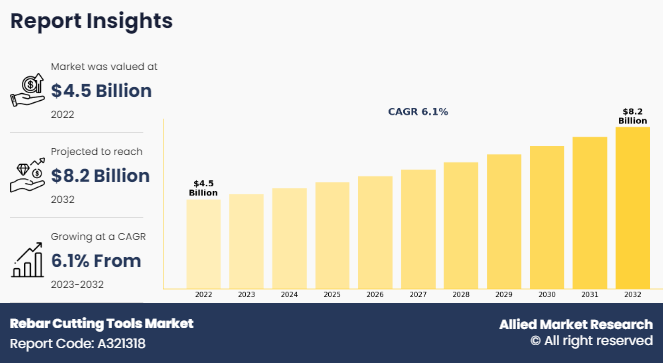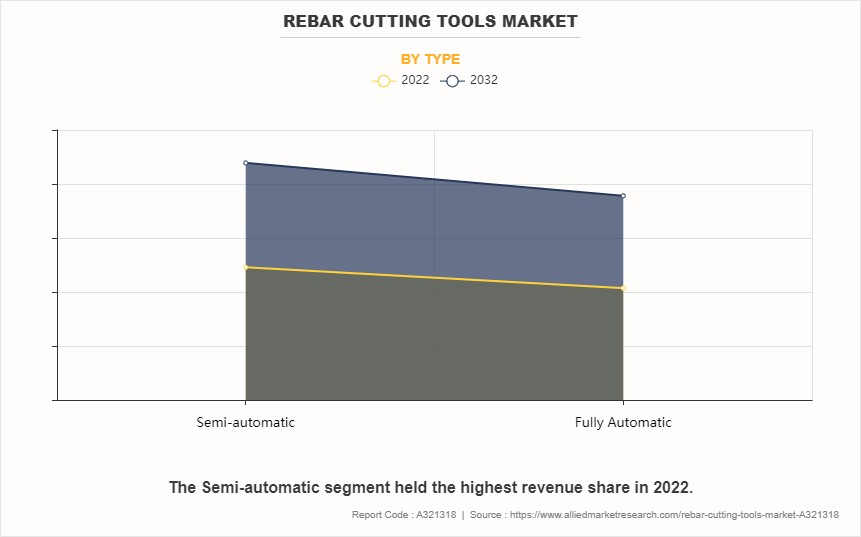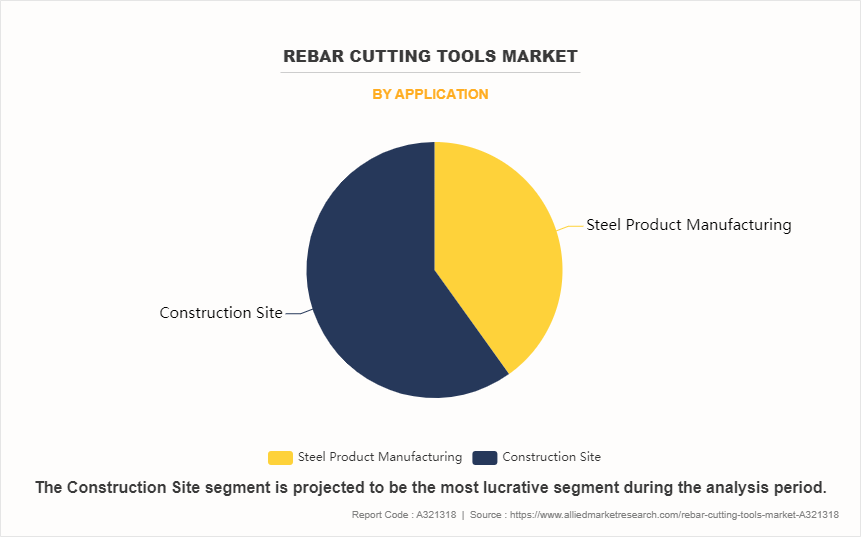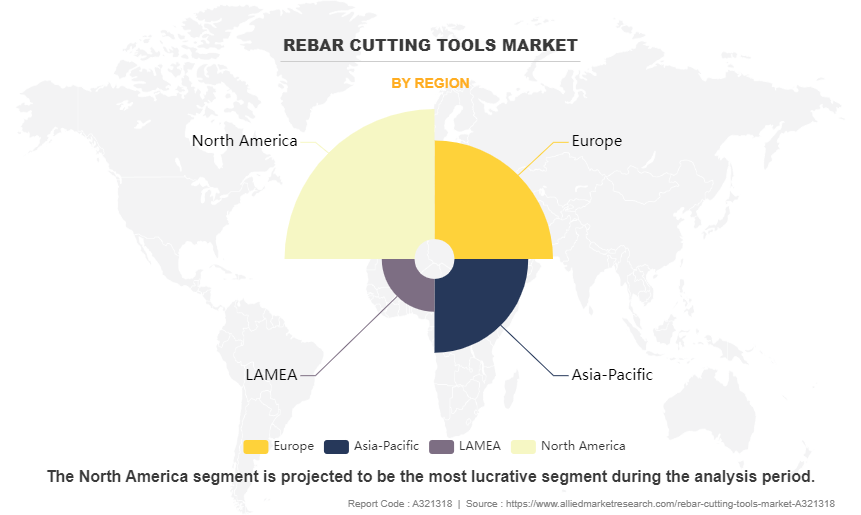Rebar Cutting Tools Market Research, 2032
The global rebar cutting tools market size was valued at $4.5 billion in 2022, and is projected to reach $8.2 billion by 2032, growing at a CAGR of 6.1% from 2023 to 2032. Rebar cutting tools are specialized instruments designed for the precise cutting of reinforced steel bars. These tools play a crucial role in construction projects where reinforced concrete structures are used. Rebars, made of steel, are utilized to provide additional strength and stability to concrete structures, such as bridges, buildings, and roads. Rebar cutting tools are engineered to efficiently and accurately slice through these sturdy metal bars to meet specific project requirements. They come in various forms, ranging from manual handheld cutters to motorized electric or hydraulic machines, each suited to different scales of construction projects.
These tools are equipped with sharp blades capable of cleanly cutting rebars without causing structural damage or compromising the integrity of the steel. The precision and reliability of rebar cutting tools is vital for ensuring the safety and durability of the constructed infrastructure. Contractors and construction workers rely on these tools to execute precise cuts according to engineering specifications, contributing to the overall quality and longevity of the concrete structures.

The rapid pace of infrastructural development, spanning across both developed and developing countries, is poised to boost a significant increase in the rebar cutting tools industry. In developed countries, where urban renewal and modernization projects are prevalent, the need for efficient rebar cutting tools is particularly evident. Likewise, in developing countries experiencing increasing urbanization and infrastructure upgrades, the demand for these tools is rising to facilitate construction activities.
For instance, in India, the $1.3 trillion national master plan for infrastructure, Gati Shakti, has been a sign to bring about systemic and effective reforms in the sector, and has already shown a substantial advancement. Infrastructure projects, ranging from highways and bridges to skyscrapers and residential complexes, rely heavily on reinforced concrete structures. As these projects multiply and expand in scale, so does the requirement for precise and reliable rebar cutting tools. Moreover, advancements in construction technologies are driving the demand for innovative cutting solutions that enhance productivity and accuracy on construction sites. Consequently, manufacturers of rebar cutting tools are anticipated to witness an increase in orders, prompting them to innovate further to meet the evolving needs of the construction industry. In essence, the changing infrastructural development landscape, characterized by both developed and developing countries, is set to boost the demand for rebar cutting tools to significant levels in the future and thus support rebar cutting tools market growth.
The absence of economic instability in various developing countries poses a significant hindrance to the rebar cutting tools market forecast in infrastructural development. Without the pressing need to streamline construction processes due to economic uncertainties, there is less urgency to invest in advanced equipment like automatic rebar cutting tools. In such environments, traditional methods persist despite their inefficiencies. For instance, in a country where economic stability has not been maintained consistently, such as Argentina, where infrastructural development is a priority and economic growth is not stable, there might be less incentive to invest in expensive rebar cutting tools. Instead, manual labor or less sophisticated equipment continue to be used, especially if the existing methods are deemed sufficient to meet project demands without significantly impacting timelines or budgets.
In regions where economic stability mitigates the urgency for efficiency gains, the adoption of rebar cutting tools in infrastructural projects might lag behind areas facing economic instability. The initial investment costs and perceived risks associated with implementing new technologies often outweigh the potential long-term benefits. Consequently, decision-makers may prioritize traditional methods over adopting innovative solutions. Unlike regions compelled by economic instability to seek efficiency improvements, those with stable economies may perceive the adoption of new technologies as less imperative. Without the pressure to streamline processes and reduce costs, there is less motivation to invest in rebar cutting tools despite their potential advantages.
The rise in industrialization has led to a robust demand for rebar cutting tools market, particularly within infrastructural development. With countries struggling to address the rising needs of their populations, the construction of vital structures such as bridges, roads, and buildings has been a major concern. Rebar is a crucial element in concrete construction, providing essential strength and stability to an array of infrastructural projects. The rapid evolution of industrial infrastructure necessitates efficient and precise tools for cutting rebar, ensuring the seamless execution of construction projects worldwide. Rebar cutting tools market overview play a crucial role in helping regions manage the challenges of urbanization and expansion. They enable the construction of robust and long-lasting infrastructure frameworks that are necessary for social advancement.
For instance, in emerging countries like India, ambitious infrastructural development plans by the government, including the construction of highways, airports, and smart cities, have led to a significant increase in the demand for rebar cutting tools. With rapid urbanization worldwide, the need for robust infrastructure becomes more evident, further driving demand for such tools. Consequently, manufacturers operating in this sector are experiencing increasing growth prospects, leading to investments in innovation and technology aimed at improving the efficiency and precision of their cutting tools. These advancements are not only aimed at the increasing demand for infrastructure, but also boost the overall growth and modernization of construction practices, thus contributing to the realization of ambitious developmental objectives.
Competitive Landscape
The key players profiled in rebar cutting tools market report are Schnell Spa, Gensco Equipment, KRB Machinery, Eurobend, PEDAX, Ltd, Toyo Kensetsu Kohki, Hitachi, Ellsen Bending Machine, TJK Machinery, and MEP Group.
Product launch and strategic partnership are common strategies followed by major market players. For instance, in January 2022, Chengdu Gute Machinery Works Co., Ltd. introduced an innovative steel rebar cutting machine, designed to meet the specific needs of customers. This innovative equipment is a refined version of the original open reinforcing steel cutter, enhanced with advanced features. In addition to incorporating an enclosed lubrication system and a clutch structure, operation and maintenance are simplified, ensuring uninterrupted performance. The machine features notable benefits, including enhanced safety measures, increased efficiency, lightweight design, and energy-saving capabilities. This device serves as an indispensable asset across construction and metal processing industries, catering to diverse needs. Capable of handling various steel forms, including plain round steel bars, deformed steel bars, as well as steel sections such as flat steel and square steel, its versatility is unmatched. For instance, in construction projects requiring precise steel cutting for reinforced structures, this machine offers high reliability and efficiency. From small-scale construction ventures to large industrial complexes, this steel rebar cutting machine would be a major machine in facilitating smooth and efficient metal processing operations.
Segment Analysis
The rebar cutting tools market share is segmented on the basis of type, application, and region. By type, the market is classified into semi-automatic and fully automatic. By application, the market is divided into steel product manufacturing and construction site. By region, the market is analyzed across North America, Europe, Asia-Pacific, and LAMEA.
The rebar cutting tools market is segmented into Type and Application.

By type, the semi-automatic sub-segment dominated the global rebar cutting tools market in 2022. The rise of semi-automatic tools has facilitated the construction industry, with their efficient and user-friendly features driving widespread adoption and market dominance. These tools are favored due to their ability to streamline rebar cutting processes, offering a balance between automation and manual control. Manufacturers and users have adopted this product, recognizing its potential to enhance productivity and workflow efficiency. The preference for semi-automatic functionality highlights a significant shift in consumer demands, reflecting the evolving needs within the construction sector. With their ability to offer both precision and ease of use, these tools have reinforced their prominent position in the global market landscape.

By application, the construction site sub-segment dominated the global rebar cutting tools market in 2022. Rebar cutting tools are essential in construction projects, enabling precise cutting of reinforcing bars (rebars) to meet various structural needs. These tools are essential across the construction sector, highlighting their vital role in reinforcing concrete structures. From towering skyscrapers to sturdy bridges, their extensive demand highlights their significance in ensuring the integrity and durability of reinforced concrete. Widely utilized on construction sites worldwide, they represent a major technology in modern construction practices. As infrastructural development rises globally, the demand for rebar cutting tools is expected to remain high, driven by the construction industry's continuous growth and expansion. Their widespread use and critical function strengthen their status as necessary assets in the construction industry, supporting the creation of resilient and reliable structures that define the urban landscapes.

By region, North America dominated the rebar cutting tools market in 2022. The region has observed numerous innovation and technological advancement in the field of rebar cutting equipment in recent years, driven by a robust market infrastructure and a flourishing construction sector. Established by companies based in this region, developments in rebar cutting tools cater to the rising demand for precision and efficiency in construction projects. This highlights North America’s steady dedication to augmenting construction standards, emphasizing both efficiency and safety. The region’s important role in this field is evident in the concentration of manufacturers, suppliers, and distributors, which further strengthens its status as the epicenter of rebar cutting technology. With a persistent pursuit of innovation, along with a thriving market environment, North America continues to drive forward the evolution of rebar cutting equipment, shaping the landscape of construction practices on a global scale.
Key Benefits For Stakeholders
- Rebar cutting tools market report provides a quantitative analysis of the market segments, current trends, estimations, and dynamics of the rebar cutting tools market analysis from 2022 to 2032 to identify the prevailing rebar cutting tools market growth.
- The market research is offered along with information related to key drivers, restraints, and opportunities.
- Porter's five forces analysis highlights the potency of buyers and suppliers to enable stakeholders make profit-oriented business decisions and strengthen their supplier-buyer network.
- In-depth analysis of the rebar cutting tools market segmentation assists to determine the prevailing market opportunities.
- Major countries in each region are mapped according to their revenue contribution to the global market.
- Market player positioning facilitates benchmarking and provides a clear understanding of the present position of the market players.
- The report includes the analysis of the regional as well as global rebar cutting tools market trends, key players, market segments, application areas, and market growth strategies.
Rebar Cutting Tools Market Report Highlights
| Aspects | Details |
| Market Size By 2032 | USD 8.2 billion |
| Growth Rate | CAGR of 6.1% |
| Forecast period | 2022 - 2032 |
| Report Pages | 290 |
| By Type |
|
| By Application |
|
| By Region |
|
| Key Market Players | MEP Group, Schnell Spa, PEDAX, Ltd., KRB Machinery, Eurobend, Toyo Kensetsu Kohki, Gensco Equipment, Hitachi, Ellsen Bending Machine, TJK Machinery |
The global rebar cutting tools market is experiencing significant growth attributed to the increasing construction activities globally.
The major growth strategies adopted by the rebar cutting tools market players are product launches and partnership agreements.
Asia-Pacific will provide more business opportunities for the global rebar cutting tools market in the future.
Schnell Spa, Gensco Equipment, KRB Machinery, Eurobend, PEDAX, Ltd, Toyo Kensetsu Kohki, Hitachi, Ellsen Bending Machine, TJK Machinery, and MEP Group are the major players in the rebar cutting tools market.
The construction site sub-segment of the type segment acquired the maximum share of the global rebar cutting tools market in 2022.
The construction industry is one of the major customers in the global rebar cutting tools market.
The report provides an extensive qualitative and quantitative analysis of the current trends and future estimations of the global rebar cutting tools market from 2022 to 2032 to determine the prevailing opportunities.
Rebar cutting tools are essential in construction projects, enabling precise cutting of reinforcing bars (rebars) to meet various structural needs. These tools are essential across the construction sector, highlighting their vital role in reinforcing concrete structures.
The rapid pace of industrialization and the concurrent development of industrial infrastructure have led to a significant demand for rebar cutting tools, particularly in the field of infrastructural development.
Loading Table Of Content...
Loading Research Methodology...



